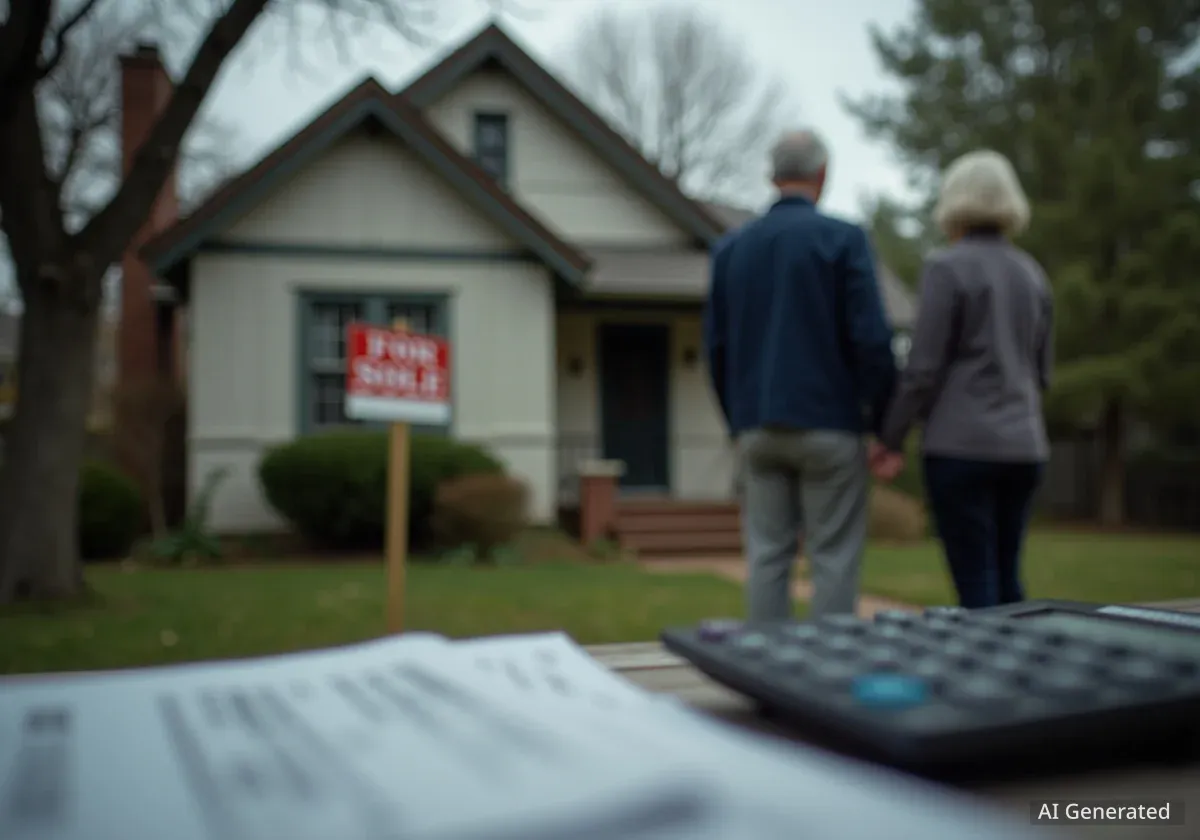Many older adults view downsizing as a way to unlock home equity and simplify their finances for retirement. However, a growing number are discovering that moving to a smaller home is not the financial windfall they anticipated, often involving unexpected costs, extensive renovations, and a competitive housing market.
Key Takeaways
- Downsizing does not always result in significant savings, as smaller, modern homes can be as expensive as larger, older ones.
- Older properties often require substantial renovations to meet the demands of younger buyers, who prefer move-in-ready homes.
- Emotional attachment and unrealistic price expectations can create significant challenges for sellers.
- Real estate experts advise planning for a downsize years in advance to avoid rushed decisions forced by health issues.
The Myth of a Profitable Downsize
When Bryn Smythe, 64, and Jack Reuben, 67, decided to sell their large, three-story home in the Philadelphia suburbs in 2023, their primary goal was to save money. They quickly learned that the process was more complicated than they expected. “In the area that we live in, it was really easy to find something equally expensive as what we just sold,” Ms. Smythe explained. “That isn’t in the cards for us.”
Their experience highlights a common misconception about downsizing. Many homeowners who have spent decades paying off a mortgage and watching their property value appreciate are surprised by the high cost of smaller homes, especially in desirable areas.
Sue Fitzgerald, a real estate agent with Compass who worked with the couple, said that seniors are “often shocked” to find that moving to a smaller home is “still quite an expensive step.” This realization can be both financially and emotionally difficult for those planning their retirement budget.
Renovations and Modern Buyer Expectations
The challenge is often compounded by the age of the housing stock. In Pennsylvania, for instance, the median home age is 60 years. According to 2023 census data, 67 percent of the state's homes were built before 1980. These older homes frequently require significant updates to attract today's buyers.
Smythe and Reuben's new townhouse needed new flooring, fresh paint, kitchen updates, and eventually a new HVAC system. While they were prepared to undertake the work, many downsizers are not. “Some people our age that are downsizing, they don’t really want to do work, they want it to be pretty much OK when they move in,” Smythe noted.
The Generational Divide in Homebuying
Real estate agents observe a distinct difference in expectations between generations. While many seniors purchased their homes with the intent of gradually updating them over time, today's millennial and Gen X buyers often have different priorities. Fitzgerald explained that younger buyers are often “spread thin” and want a home that is fresh and ready for immediate occupancy, a stark contrast to the mindset of previous generations.
To bridge this gap, sellers of older homes may need to invest in renovations before listing their property. Marie Gordon, another Compass agent, said that modernizing a home can add significant value, sometimes double the amount invested. However, she cautions that these decisions should be guided by market trends, not just personal taste.
“If they go in and say, ‘I’m going to redo my kitchen and make my house more valuable,’ but they choose everything that they like, that might not be the trend, that’s not going to serve them well.”
Strategic Updates Yield Better Returns
Not all pre-sale investments are equal. Before selling their home, Smythe and Reuben considered refinishing the floors. Their agent, Ms. Fitzgerald, advised against the costly project. Instead, she recommended more cost-effective updates like reglazing the original bathtubs. This targeted advice paid off, and their house sold just two days after being listed.
Agents also emphasize the importance of smaller, cosmetic changes. Removing dated wallpaper, old carpets, and heavy draperies can make a home appear brighter and more modern in online photos. In an era where most buyers start their search online, visual appeal is critical.
The Power of a Picture
A recent report from the National Association of Realtors (NAR) found that 83 percent of homebuyers consider photographs to be a very valuable feature when searching for a home online. Homes with professional, appealing photos tend to sell faster and for a better price.
Navigating a Complex Market
Even with a desirable property, market conditions can add another layer of complexity. Kate and Paul Herman, both 57, sold their home in Radnor, Pennsylvania, in June. However, the house they purchased in Malvern required a complete renovation, forcing them to find a temporary rental.
“Our ideal would have been to sell and to purchase the home that we would move into,” Ms. Herman said. “Eventually it became clear that we weren’t going to be able to do that, and so we were going to have to find a bridge solution, which was renting.”
While the Hermans had no trouble selling their “architectural gem” to young buyers, they noted the financial strain on the new generation. Their buyers relied on a mix of mortgages and financial support from their parents to afford the home.
Patrick Gourley, a professor of economics at the University of New Haven, commented on the market dynamics. “The market is not functioning as well as it did pre-Covid, and so that kind of makes it harder for people of any age to move,” he said. While it remains a seller's market, homeowners may have inflated expectations.
“Anyone who says they’re having problems selling a home right now is actually having a problem selling their home for the price they want.”
The Emotional and Practical Reasons for Delay
Financial hurdles are not the only reason older adults postpone downsizing. The emotional attachment to a family home, filled with memories and personal belongings, can make the decision to leave incredibly difficult. Ms. Fitzgerald described it as feeling like “moving down” the housing ladder, which can bring a sense of loss.
In recent years, another factor has emerged: the financial struggles of adult children. Some seniors are choosing to keep their larger homes to provide a safety net for their children, who face high housing costs and a difficult market.
Data from the NAR highlights the varied motivations among older adults:
- 30% of those aged 60 to 69 are motivated to move for health reasons.
- 30% report that they never want to move from their current home.
- Only 19% are actively motivated by a desire to downsize.
The Importance of Proactive Planning
Real estate professionals universally agree on one piece of advice: don't wait for a crisis. Too often, a health scare, such as a fall, forces a hasty and stressful move. This leaves little time for proper financial planning or making thoughtful decisions about where to live next.
“It’s never too early,” Fitzgerald stressed. Planning ahead allows homeowners to make strategic updates, declutter at a manageable pace, and explore their options without pressure.
Starting the process early ensures a smoother, more successful transition, allowing seniors to take control of their next chapter rather than having it dictated by an emergency. “The process will go much more smoothly and will be much more successful if it starts earlier,” she concluded.





